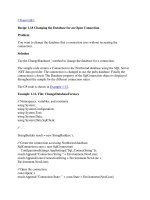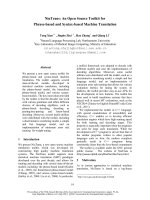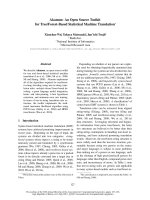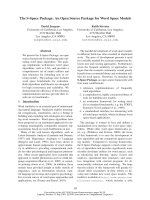Creating an Open Source SAN
Bạn đang xem bản rút gọn của tài liệu. Xem và tải ngay bản đầy đủ của tài liệu tại đây (540.39 KB, 35 trang )
161
CHAPTER 7
Creating an Open Source SAN
Configuring a DRBD and
Heartbeat on Ubuntu Server
I
n a modern network, a shared storage solution is indispensable. Using shared storage
means that you can make your server more redundant. Data is stored on the shared
storage, and the servers in the network simply access this shared storage. To prevent
the shared storage from becoming a single point of failure, mirroring is normally
applied. That means that the shared storage solution is configured on two servers: if
one goes down, the other takes over. To implement such a shared storage solution,
some people spend thousands of dollars on a proprietary storage area network (SAN)
solution. That isn’t necessary. In this chapter you will learn how to create a shared stor-
age solution using two server machines and Ubuntu Server software, what I refer to as
an open source SAN.
There are three software components that you’ll need to create an open source SAN:
sDistributed Replicated Block Device (DRBD): This component allows you to cre-
ate a replicated disk device over the network. Compare it to RAID 1, which is disk
mirroring but with a network in the middle of it (see Chapter 1). The DRBD is the
storage component of the open source SAN, because it provides a storage area. If
one of the nodes in the open source SAN goes down, the other node will take over
and provide seamless storage service without a single bit getting lost, thanks to
the DRBD. In the DRBD, one node is used as the primary node. This is the node to
which other servers in your data center connect to access the shared storage. The
other node is used as backup. The Heartbeat cluster (see the third bullet in this
list) determines which node is which. Figure 7-1 summarizes the complete setup.
CHAPTER 7
N
CREATING AN OPEN SOURCE SAN
162
Figure 7-1. For best performance, make sure your servers have two network
interfaces.
siSCSI target: To access a SAN, there are two main solutions on the market: Fibre
Channel and iSCSI. Fibre Channel requires a fiber infrastructure to access the
SAN. iSCSI is just SCSI, but over an IP network. There are two parts in an iSCSI
solution. The iSCSI target offers access to the shared storage device. All servers
that need access use an iSCSI initiator, which is configured to make a connection
with the iSCSI target. Once that connection is established, the server that runs the
initiator sees an additional storage device that gives it access to the open source
SAN.
sHeartbeat: Heartbeat is the most important open source high- availability cluster
solution. The purpose of such a solution is to make sure that a critical resource
keeps on running if a server goes down. Two critical components in the open
source SAN are managed by Heartbeat. Heartbeat decides which server acts as the
DRBD primary node, and ensures that the iSCSI target is activated on that same
server.
CHAPTER 7
N
CREATING AN OPEN SOURCE SAN
163
Preparing Your Open Source SAN
To prepare your open source SAN, you need to make sure that you have everything
necessary to set up the open source SAN. Specifically, you need to make sure that your
hardware meets the requirements of a SAN configuration, so that you can install the soft-
ware needed to create the solution.
Hardware Requirements
The hardware requirements are not extraordinary. Basically, any server that can run
Ubuntu Server will do, and because the DRBD needs two servers, you must have two
such servers to set this up. You need a storage device to configure as the DRBD, though.
For best performance, I recommend using a server that has a dedicated hard disk for
operating system installation. This can be a small disk—a basic 36 GB SCSI disk is large
enough—and if you prefer, you can use SATA as well.
Apart from that, it is a good idea to have a dedicated device for the DRBD. Ideally,
each server has a RAID 5 array to use as the DRBD, but if you can’t provide that, a dedi-
cated disk is good as well. If you can’t use a dedicated disk, make sure that each of the
servers has a dedicated partition to be used in the DRBD setup. The storage devices that
you are going to use in the DRBD need to be of equal size.
You also need decent networking. Because you are going to synchronize gigabytes of
data, gigabit networking is indispensable. I recommend using a server with at least two
network cards, one card to use for synchronization between the two block devices, and
the other to access the iSCSI target.
Installing Required Software
Before you start to set up the open source SAN, it’s a good idea to install all software that
is needed to build this solution. The following procedure describes how to do that:
1. Make sure that the software repositories are up to date, by using the
]lp)cap
ql`]pa
command.
2. Use
]lp)capejop]hh`n^`4)qpeho
to install the DRBD software.
3. Use
]lp)capejop]hheo_oep]ncap
to install the iSCSI target.
4. Use
]lp)capejop]hhda]np^a]p).
to install the Heartbeat software.
All required software is installed now, so it’s time to start creating the DRBD.
CHAPTER 7
N
CREATING AN OPEN SOURCE SAN
164
Setting Up the Distributed Replicated Block Device
It’s time to take the first real step in the SAN configuration and set up the DRBD. Make
sure that you have a storage device available on each of the servers involved in setting
up the SAN. In this chapter, I’ll assume that the name of the storage device is
+`ar+o`^
.
To configure the DRBD, you have to create the file
+ap_+`n^`*_kjb
, an example of which
is shown in Listing 7-1. You can remove its contents and replace it with your own
configuration.
Listing 7-1. The DRBD Is Configured from /etc/drbd.conf
o]j-6+ap__]p`n^`*_kjb
^acejnaokqn_a`n^`,
naokqn_a`n^`,w
lnkpk_kh?7
op]npqlw`acn)sb_)peiakqp-.,7y
`eogwkj)ek)annkn`ap]_d7y
japwy
ouj_anw
n]pa-,,i7
]h)atpajpo.137
y
kjo]j-w
`are_a+`ar+`n^`,7
`eog+`ar+o`^7
]``naoo-5.*-24*-*./,633447
iap])`eogejpanj]h7
y
kjo]j.w
`are_a+`ar+`n^`,7
`eog+`ar+o`^7
]``naoo-5.*-24*-*.0,633447
iap])`eogejpanj]h7
y
y
aj`naokqn_a`n^`,
In this example configuration file, one DRBD is configured, named
+`ar+`n^`,
. The
configuration file starts with the definition of the resource
`n^`,
. If you would like to add
another resource that has the name
`n^`-
, you would add the
naokqn_a`n^`-w***y
CHAPTER 7
N
CREATING AN OPEN SOURCE SAN
165
specification later in the file. Each resource starts with some generic settings, the first of
which is always the protocol setting. There are three protocols, A, B, and C, and of the
three, protocol C offers the best performance. Next, there are four generic parts in the
configuration:
s
op]npql
: Defines parameters that play a role during the startup phase of the DRBD.
As you can see, there is just one parameter here, specifying that a timeout of 120
seconds is used. After this timeout, if a device fails to start, the software assumes
that it is not available and tries periodically later to start it.
s
`eog
: Specifies what has to happen when a disk error occurs. The current setting
k
n
)ek)annkn`ap]_d
makes sure that the disk device is no longer used if there is an
error. This is the only parameter that you’ll really need in this section of the setup.
s
jap
: Contains parameters that are used for tuning network performance. If you
really need the best performance, using
i]t)^qbbano.,04
makes sense here. This
parameter makes sure that the DRBD is capable of handling 2048 simultaneous
requests, instead of the default of 32. This allows your DRBD to function well in an
environment in which lots of simultaneous requests occur.
s
ouj_an
: Defines how synchronization between the two nodes will occur. First, the
synchronization rate is defined. In the example shown in Listing 7-1, synchroniza-
tion will happen at 100 MBps (note the setting is in megabytes, not megabits). To
get the most out of your gigabit connection, you would set it to
-,,i
(i.e., almost
1 Gbps), but you should only do this if you have a dedicated network card for syn-
chronization. The parameter
]h)atpajpo.13
defines the so- called active group,
a collection of storage that the DRBD handles simultaneously. The syncer works
on one active group at the same time, and this parameter defines an active group
of 257 extents of 4 MB each. This creates an active group that is 1 GB, which is fine
in all cases. You shouldn’t have to change this parameter.
After the generic settings in
+ap_+`n^`*_kjb
comes the part where you define
node- specific settings. In the example shown in Listing 7-1, I used two nodes,
o]j-
and
o]j.
. Each node has four lines in its definition:
sThe name of the DRBD that will be created: It should be
+`ar+`n^`,
in all cases for
the first device that you configure.
sThe name of the device that you want to use in the DRBD setup: This example uses
+`ar+o`^
, to make sure that on your server you are using the device that you have
dedicated to this purpose.
CHAPTER 7
N
CREATING AN OPEN SOURCE SAN
166
sThe IP address and port of each of the two servers that participate in the DRBD con-
figuration: Make sure that you are using a fixed IP address here, to eliminate the
risk that the IP address could suddenly change. Every DRBD needs its own port,
so if you are defining a
+`ar+`n^`-
resource later in the file, it should have a unique
port. Typically, the first DRBD has port 7788, the second device has 7789, and so
on.
sThe parameter that defines how to handle metadata : You should use the param-
eter
iap])`eogejpanj]h
. This parameter does well in most cases, so you don’t need
to change it.
This completes the configuration of the DRBD. Now you need to copy the
+ap_+`n^`*
_kjb
file to the other server. The following command shows you how to copy the
`n^`*_kjb
file from the current server to the
+ap_
directory on the server
o]j.
:
o_l+ap_+`n^`*_kjbo]j.6+ap_+
Now that you have configured both servers, it’s time to start the DRBD for the first
time. This involves the following steps:
1. Make sure that the DRBD resource is stopped on both servers. Do this by entering
the following command on both servers:
+ap_+ejep*`+`n^`opkl
2. Create the device and its associated metadata, on both nodes. To do so, run the
`n^`]`i_na]pa)i``n^`,
command. Listing 7-2 shows an example of its output.
Listing 7-2. Creating the DRBD
nkkp<o]j-6z`n^`]`i_na]pa)i``n^`,
r,4I]ce_jqi^anjkpbkqj`
i`[kbboap/55551.452,
]h[kbboap/5555052-5.
^i[kbboap/5554.3-044
Bkqj`okia`]p]
99:Pdeoiecdp`aopnkuateopejc`]p]899
@kukqs]jppklnk_aa`;
Wjaa`pkpula#uao#pk_kjbeniYuao
CHAPTER 7
N
CREATING AN OPEN SOURCE SAN
167
r,3I]ce_jqi^anjkpbkqj`
r,3I]ce_jqi^anjkpbkqj`
r,4I]ce_jqi^anjkpbkqj`
Snepejciap]`]p]***
ejepe]heoejc]_perepuhkc
JKPejepe]heva`^epi]l
Jas`n^`iap]`]p]^hk_goq_aoobqhhu_na]pa`*
))99?na]pejciap]`]p]99))
=osepdjk`aosa_kqjppdapkp]hjqi^ankb`are_aoiennkna`^u@N>@]p
]pdppl6++qo]ca*`n^`*knc*
Pda_kqjpanskngo_kilhapahu]jkjuikqo*=n]j`kijqi^ancapo_na]pa`bkn
pdeo`are_a(]j`pd]pn]j`kianjqi^an]j`pda`are_aooevasehh^aoajp*
dppl6++qo]ca*`n^`*knc+_ce)^ej+ejoanp[qo]ca*lh;jq9.,0,,.,120-1.2.20,-"nq
±
9-,45/240/43225-5/342"no9/55551/220,
Ajpan#jk#pkklpkqp(knfqoplnaooWnapqnjYpk_kjpejqa6
oq__aoo
3. Make sure the
`n^`
module is loaded on both nodes, and then associate the DRBD
resource with its backing device:
ik`lnk^a`n^`
`n^`]`i]pp]_d`n^`,
4. Connect the DRBD resource with its counterpart on the other node in the setup:
`n^`]`i_kjja_p`n^`,
5. The DRBD should run properly on both nodes now. You can verify this by using
the
+lnk_+`n^`
file. Listing 7-3 shows an example of what it should look like at this
point.
Listing 7-3. Verifying in /proc/drbd that the DRBD Is Running Properly on Both Nodes
o]j-6z_]p+lnk_+`n^`
ranoekj6,*3*..$]le635+lnkpk630%
ORJNareoekj6.13.^qeh`^uhi^<`]ha(.,,2)-,).1-46-36.-
,6_o6?kjja_pa`op6Lnei]nu+Oa_kj`]nuh`6?kjoeopajp
jo6,jn6,`s6,`n6,]h6,^i6,hk6,la6,q]6,]l6,
CHAPTER 7
N
CREATING AN OPEN SOURCE SAN
168
6. As you can see, the DRBD is set up now, but both nodes at this stage are config-
ured as secondary in the DRBD setup, and no synchronization is happening yet.
To start synchronization and configure one node as primary, use the following
command on one of the nodes:
`n^`]`i))))kransnepa)`]p])kb)laanlnei]nu`n^`,
This starts synchronization from the node where you enter this command to the
other node.
N
Caution
At this point, you will start erasing all data on the other node, so make sure that this is really
what you want to do.
7. Now that the DRBD is set up and has started its synchronization, it’s a good idea to
verify that this is really happening, by looking at
+lnk_+`n^`
once more. Listing 7-4
shows an example of what it should look like at this point. It will take some time
for the device to synchronize completely. Up to that time, the device is marked as
inconsistent. That doesn’t really matter at this point, as long as it is up and works.
Listing 7-4. Verify Everything Is Working Properly by Monitoring /proc/drbd
nkkp<o]j-6z_]p+lnk_+`n^`
ranoekj64*,*--$]le642+lnkpk642%
CEP)d]od6^/ba.^`b`/^5b3_.b5./-4244/a^5a.],`/]1^-^^qeh`^uldeh<iao_]h(
±
.,,4),.)-.--61260/
,6_o6Ouj_Okqn_aop6Lnei]nu+Oa_kj`]nu`o6QlPk@]pa+Ej_kjoeopajp?n)))
jo62.-00jn6,`s6,`n62.-00]h6,^i6/hk6,la6,q]6,]l6,
W:********************Youj_#a`6,*.!$/4,40+/4-01%I
bejeod6-46,/6-3olaa`60,,$/.,%G+oa_
naouj_6qoa`6,+/-depo6/44,ieooao60op]nrejc6,`enpu6,_d]jca`60
]_p[hkc6qoa`6,+.13depo6,ieooao6,op]nrejc6,`enpu6,_d]jca`6,
In the next section you’ll learn how to configure the iSCSI target to provide access to
the DRBD from other nodes.
CHAPTER 7
N
CREATING AN OPEN SOURCE SAN
169
N
Tip
At this point it’s a good idea to verify that the DRBD starts automatically. Reboot your server to
make sure that this happens. Because you haven’t configured the cluster yet to make one of the nodes
primary automatically, on one of the nodes you have to run the
`n^`]`i))))kransnepa)`]p])kb)laan
lnei]nu`n^`,
command manually, but only after rebooting. At a later stage, you will omit this step
because the cluster software ensures that one of the nodes becomes primary automatically.
Accessing the SAN with iSCSI
You now have your DRBD up and running. It is time to start with the second part of
the configuration of your open source SAN, namely the iSCSI target configuration. The
iSCSI target is a component that is used on the SAN. It grants other nodes access to
the shared storage device. In the iSCSI configuration, you are going to specify that the
+`ar+`n^`,
device is shared with the iSCSI target. After you do this, other servers can use
the iSCSI initiator to connect to the iSCSI target. Once a server is connected, it will see
a new storage device that refers to the shared storage device. In this section you’ll first
read how to set up the iSCSI target. The second part of this section explains how to set
up the iSCSI initiator.
Configuring the iSCSI Target
You can make access to the iSCSI target as complex as you want. The example configura-
tion file
+ap_+eap`*_kjb
gives an impression of the possibilities. If, however, you want to
create just a basic setup, without any authentication, setting up an iSCSI target is not too
hard. The first thing you need is the iSCSI Qualified Name (IQN) of the target. This name
is unique on the network and is used as a unique identifier for the iSCSI target. It typically
has a name like
emj*.,,4),4*_ki*o]j`anr]jrqcp6`n^``e
sk. This name consists of four dif-
ferent parts. The IQN of all iSCSI targets starts with
emj
, followed by the year and month
in which the iSCSI target was configured. Next is the inverse DNS domain name, and the
last part, just after the colon, is a unique ID for the iSCSI target.
The second part of the configuration file that you will find in each iSCSI target refers
to the disk device that is shared. It is a simple line, like
Hqj,L]pd9+`ar+o`_(Pula9behaek
.
This line gives a unique logical unit number (LUN) ID to this device, which in this case is
hqj,
. Following that is the name of the device that you are sharing. When sharing devices
the way I demonstrate in this section, the type will always be
behaek
. You can configure
one LUN, which is what we need in this setup, but if there are more devices that you want
to share, you can configure a LUN for each device. Listing 7-5 gives an example of a setup
CHAPTER 7
N
CREATING AN OPEN SOURCE SAN
170
in which two local hard disks are shared with iSCSI (don’t use it in your setup of the open
source SAN—it’s just for demonstration purposes!).
Listing 7-5. Example of an iSCSI Target that Gives Access to Two Local Disk Devices
P]ncapemj*.,,4),4*_ki*o]j`anr]jrqcp6iup]ncap
Hqj,L]pd9+`ar+o`^(Pula9behaek
Hqj-L]pd9+`ar+o`_(Pula9behaek
The last part of the iSCSI target configuration is optional and may contain param-
eters for optimization. The example file gives some default values, which you can increase
to get a better performance. For most scenarios, however, the default values work fine, so
there is probably no need to change them. Listing 7-6 shows the default parameters that
are in the example file.
Listing 7-6. The Example ietd.conf Gives Some Suggestions for Optimization Parameters
I]t?kjja_pekjo-
Ejepe]hN.PUao
Eiia`e]pa@]p]Jk
I]tNa_r@]p]OaciajpHajcpd4-5.
I]tTiep@]p]OaciajpHajcpd4-5.
I]t>qnopHajcpd.2.-00
Benop>qnopHajcpd211/2
@ab]qhpPeia.S]ep.
@ab]qhpPeia.Nap]ej.,
I]tKqpop]j`ejcN.P4
@]p]L@QEjKn`anUao
@]p]Oamqaj_aEjKn`anUao
AnnknNa_kranuHarah,
Da]`an@ecaop?N?/.?(Jkja
@]p]@ecaop?N?/.?(Jkja
r]nekqop]ncapl]n]iapano
Spdna]`o4
As the preceding discussion demonstrates, iSCSI setup can be really simple. Just
provide an IQN for the iSCSI target and then tell the process to which device it should
offer access. In our open source SAN, this is the DRBD. Note, however, that there is one
important item that you should be careful with: iSCSI target should always be started on
CHAPTER 7
N
CREATING AN OPEN SOURCE SAN
171
the node that is primary in the DRBD setup. Later you will configure the cluster to do that
automatically for you, but at this point, you should just take care that it happens manu-
ally. To determine which of the nodes is running as primary, check
+lnk_+`n^`
. The node
that shows the line
Ouj_Okqn_aop6Lnei]nu+Oa_kj`]nu
is the one on which you should start
the iSCSI target.
Configuring the iSCSI target at this point is simple:
1. Create the
+ap_+eap`*_kjb
file. It should exist on both nodes and have exactly the
same contents. The example file in Listing 7-7 shows what it should look like.
Listing 7-7. Use This Configuration to Set Up the ISCSI Target
P]ncapemj*.,,4),4*_ki*o]j`anr]jrqcp6klajokqn_ao]j
Hqj,L]pd9+`ar+`n^`,(Pula9behaek
2. On installation, the iSCSI target script was added to your runlevels automatically.
You should now stop and restart it. To do this, run the
+ap_+ejep*`+eo_oep]ncap
opkl
command. Next run
+ap_+ejep*`+eo_oep]ncapop]np
, and it should all work.
Now that your iSCSI target apparently is up and running, you should double- check
that indeed it is. To do that, you need to know about the iSCSI target ID. You can get that
from the file
+lnk_+jap+eap+rkhqia
. If at a later stage you want to find out about session
IDs, check the
+lnk_+jap+eap+oaooekj
file for those. Listing 7-8 shows what the
+lnk_+jap+
eap+rkhqia
file looks like.
Listing 7-8. Getting Information About Currently Operational iSCSI Targets from /proc/net/
iet/volume
nkkp<o]j-6z_]p+lnk_+jap+eap+rkhqia
pe`6-j]ia6emj*.,,4),4*_ki*o]j`anr]jrqcp6klajokqn_ao]j
hqj6,op]pa6,ekpula6behaekekik`a6spl]pd6+`ar+`n^`,
As you can see, the target ID (
pe`
) of the iSCSI target device that you’ve just config-
ured is 1. Knowing that, you can display status information about that target with the
eap]`i
command. To do that, use
eap]`i))klodks))pe`
=1. The output of this command
will be similar to the output shown in Listing 7-9.
CHAPTER 7
N
CREATING AN OPEN SOURCE SAN
172
Listing 7-9. Use ietadm to Get More Details About a Particular iSCSI Target
nkkp<o]j-6zeap]`i))klodks))pe`9-
Spdna]`o94
Pula9,
Mqaqa`?kii]j`o9/.
At a later stage, you can also use
eap]`i
to get more information about currently exist-
ing sessions.
Before you continue, there is one item that you should take care of. Once the Heart-
beat cluster is configured, Heartbeat will decide where the iSCSI target software has
started and is running. Therefore, it may not be started automatically from the runlevels.
The following procedure shows you how to switch it off using the optional
ouor_kjbec
tool:
1. Use
]lp)capejop]hhouor_kjbec
to install the
ouor_kjbec
tool on both nodes.
2. Start
ouor_kjbec
and, from the main interface, select enable/disable service.
3. As shown in Figure 7-2, browse to the
eo_oep]ncap
service and switch it off by
pressing the spacebar on your keyboard.
Figure 7-2. Select the iscsitarget service to switch it off.
4. Quit the
ouor_kjbec
editor.
CHAPTER 7
N
CREATING AN OPEN SOURCE SAN
173
Configuring the iSCSI Initiator
The purpose of an iSCSI initiator is to access shared storage offered by an iSCSI target.
This shared storage can be nodes in a high- availability cluster or stand- alone nodes. In
this section I’ll explain how to configure the iSCSI initiator on a third node, which will
allow you to test that everything is working as expected. Once configured properly, the
iSCSI initiator will give a new storage device to the server that is accessing the iSCSI SAN.
So if your server just had a
+`ar+o`]
device before connecting to the iSCSI target, after
making connection, it will have a
+`ar+o`^
device as well. Figure 7-3 gives a schematic
overview of what you are going to do in this section.
Figure 7-3. The iSCSI initiator will provide a new SCSI device on the nodes that use it.
Every operating system has its own solutions to set up an iSCSI initiator. If you want
to set it up on Linux, the
klaj)eo_oe
solution is the most appropriate. First, make sure that
it is installed, by running the following command:
]lp)capejop]hhklaj)eo_oe
Once installed, you can start its configuration. To do this, use the
eo_oe]`i
command.
First, you need to discover all available iSCSI targets with this command. After you dis-
cover them, you need to use the same command to make a connection. The following
procedure shows you how to do this:
CHAPTER 7
N
CREATING AN OPEN SOURCE SAN
174
1. From the node that needs to access the storage on the SAN, use the
eo_oe]`i
com-
mand as displayed in Listing 7-10. This gives you an overview of all iSCSI targets
offered on the IP address that you query.
Listing 7-10. Use iscsiadm to Discover All Available Targets
nkkp<iah6zeo_oe]`i))ik`a`eo_kranu))pulaoaj`p]ncapo))lknp]h
±
-5.*-24*-*./,
-5.*-24*-*./,6/.2,(-emj*.,,4),4*_ki*o]j`anr]jrqcp6klajokqn_ao]j
2. Now that you have located an available iSCSI target, use the
eo_oe]`i
command to
log in to it. The following command shows how to do that:
eo_oe]`i))ik`ajk`a))p]ncapj]iaemj*.,,4),4*_ki*o]j`anr]jrqcp6klajokqn_ao]j
±
))lknp]h-5.*-24*-*./,6/.2,))hkcej
3. If it succeeds, this command will tell you that you are now connected. If you want
to verify existing connections, use the
eo_oe]`i)i
oaooekj
command to display
a list of all current iSCSI sessions. Listing 7-11 shows an example of its output; you
can now recognize the iSCSI device, which is marked as the IET device type.
Listing 7-11. Use lsscsi to Check Whether the New iSCSI Device Was Properly Created
nkkp<iah6zhoo_oe
W.6,6,6,Y`eog=P=OP/1,,2/,=O/*==+`ar+o`]
W/6,6,6,Y`eog=P=OP/1,,2/,=O/*==+`ar+o`^
W16,6,6,Y_`+`r`HEPA)KJ@R@NSHD).,=-O5H,3+`ar+o_`,
W26,6,6,Y`eogCajane_OPKN=CA@ARE?A52,.+`ar+o`_
W26,6,6-Y`eogCajane_OPKN=CA@ARE?A52,.+`ar+o``
W26,6,6.Y`eogCajane_OPKN=CA@ARE?A52,.+`ar+o`a
W26,6,6/Y`eogCajane_OPKN=CA@ARE?A52,.+`ar+o`b
W36,6,6,Y`eogEAPRENPQ=H)@EOG,+`ar+o`c
The advantage of the iSCSI initiator configuration with
eo_oe]`i
is that the configu-
ration settings are automatically written to configuration files at the moment you apply
them. This, however, also has a disadvantage: the same iSCSI connection will always be
reestablished. If after a change of configuration you need to change which iSCSI connec-
tion is automatically restored, you need to use
eo_oe]`i
to manually remove your iSCSI
connection. If you wanted to do that for the iSCSI connection that was just established,
the following command would do the job:









